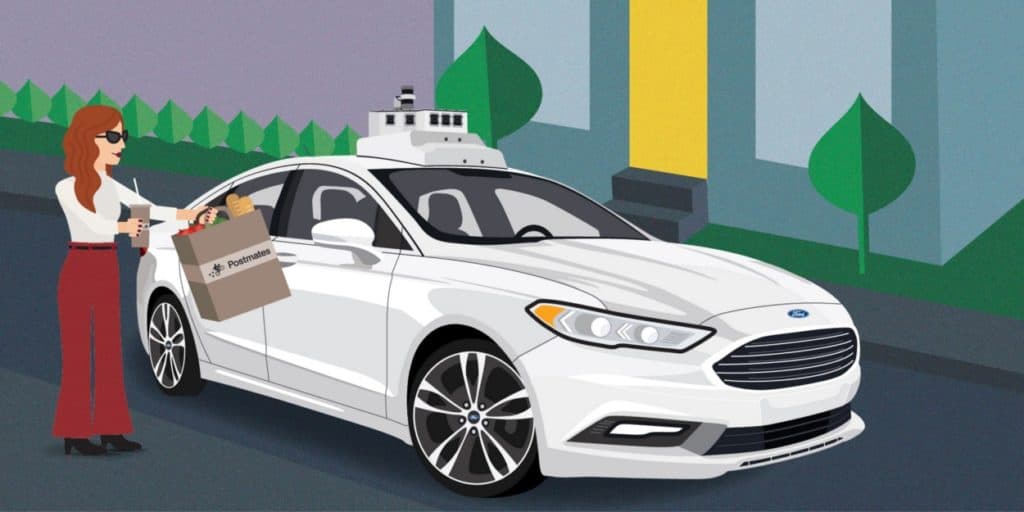 Ford’s CEO Jim Hacket at CES showed how Ford is being re-engineered to help lead to shift of mobility through the design of smart vehicles for a smart world to help people move more safely, confidentially and freely. Ford’s vision of the future includes new mobility, cloud data, on-demand services and C-V2X.
Ford’s CEO Jim Hacket at CES showed how Ford is being re-engineered to help lead to shift of mobility through the design of smart vehicles for a smart world to help people move more safely, confidentially and freely. Ford’s vision of the future includes new mobility, cloud data, on-demand services and C-V2X.
“We’re here today with a generation a new disruptive technologies feathering into the automotive world. These new technologies and innovations making it possible to share resources in ways we thought could never be done before,” said Hackett in a keynote address who asked, “How do we combine vehicles and technology so that they become more than their parts?. It’s not about the cities getting smarter but the humans having a better day.”
Marcie Klevron, executive vice president and president of mobility at Ford announced that Ford is building the open-mobility cloud Transportation Mobility Cloud for everyone, for the entire transportation operating system, including other automakers to share data to improve transportations systems, mobility and traffic. It will enable smart connected transportation. Services can be built on cloud that includes mapping, data and payments.
 Jim Farley, executive vice president and president global markets at Ford Motor Company– announced Ford is teaming up with Postmates and on-demand delivery of anything from anywhere right to your doorstep — from restaurant carryout and coffee shop orders to hardware store items and grocery goods. Postmates is the first partner for Ford’s self-driving vehicle program. Ford and Postmates will conduct pilot programs to explore how self-driving technology could change the delivery experience for consumers.
Jim Farley, executive vice president and president global markets at Ford Motor Company– announced Ford is teaming up with Postmates and on-demand delivery of anything from anywhere right to your doorstep — from restaurant carryout and coffee shop orders to hardware store items and grocery goods. Postmates is the first partner for Ford’s self-driving vehicle program. Ford and Postmates will conduct pilot programs to explore how self-driving technology could change the delivery experience for consumers.
For current Ford drivers who like crowd-sourced traffic and mapping they soon will be able to use Waze.Ford at CES announced that the Waze navigation app will soon work with Ford vehicles with SYNC 3.
Ford is also working with Qualcomm for C-V2X, high speed 5G data service that can communicate to vehicles, cities and more.
C-V2X is a highly advanced wireless connectivity technology for safety-conscious and automated driving solutions, which has the potential to help cities create more capable infrastructure as they look at how to connect vehicles to their surroundings, and to larger communications systems, facilitating the development and delivery of smart, connected transportation throughout the world. The technology is planned for further field validations beginning in 1H 2018.
As the automotive industry prepares for advancements towards 5G, Qualcomm Technologies and Ford plan to explore next-generation telematics platform concepts featuring C-V2X technology.
Using direct communication mode, C-V2X is designed to allow vehicles to directly communicate with other vehicles, pedestrian devices, and roadside infrastructure, such as traffic signs and construction zones, without the involvement of a cellular network, or cellular network subscription. Importantly, these capabilities supported by some of the latest advancements in wireless technology based on today’s standards, such as 3rd Generation Partnership Project (3GPP) Release 14 specifications and ITS standards, while also providing a strong path towards 5G. This means C-V2X-enabled vehicles are designed to remain compatible with future devices, services and infrastructure that connect via 5G technology.
Wireless communication is expected to play important role as autonomous vehicles are expected to be ubiquitous on city streets today and in the future. By facilitating communication between vehicles and a variety of other Smart City constituents, C-V2X technology complements Advanced Driver Assistance Systems (ADAS) sensors to help build a comprehensive picture of the world in which vehicles must navigate. C-V2X is designed to allow vehicles to provide information about the vehicle’s surroundings and identify objects that may be out of view, including accidents that are further down the road, or pedestrians that are obstructed by large trucks or buildings.
As a part of the ongoing relationship, the companies are working on automotive telematics platforms with integrated Qualcomm® Snapdragon™ LTE modems to provide the fast, reliable and efficient connectivity needed for telematics applications, connected navigation and infotainment systems. As the automotive industry prepares for advancements towards 5G, Ford and Qualcomm Technologies plan to work on next-generation telematics concepts and solutions featuring C-V2X technology.